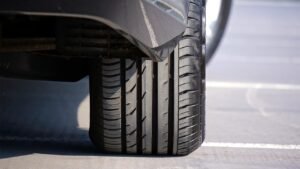The United Kingdom and Ireland both require tire pressure sensors on all vehicles to meet government standards. In fact, they’ve been required since 2014, so if you drive a vehicle made in the last 8 years, it should have the appropriate tire pressure sensors installed.
A tire pressure sensor is a small device that is attached to each tire. It is part of your vehicle’s Tire Pressure Monitoring System or TPMS. The sensor monitors the air pressure in your tires and sends the data to your vehicle’s computer, which then displays it on your dashboard or another screen. It’s designed to warn you when one or more of your tires are under-inflated, which can be dangerous.
While having under-inflated tires is dangerous, it’s also equally dangerous to have faulty tire pressure sensors. Having faulty sensors could mean that you are being informed that your tire is alright when it is not or that your tire is under-inflated when it’s totally fine. Any wrong information can affect your decision making and lead to an accident.
Should You Replace a Faulty Tire Pressure Sensor?
If you don’t replace your faulty tire pressure sensor, you run the risk of driving over something and puncturing your tire. If this happens, it may be difficult to tell that you have a flat because the low air pressure warning should have already been triggered but is not being displayed on your dashboard.
You may end up realising a bit too late that you are driving with a flat tire and you run a few metres more before making a full stop. Since driving on a flat can cause significant damage to your wheel, brake system, and other parts of the wheel assembly, this is not good for the long-term performance or safety of your vehicle. In short: replacing your faulty tire pressure sensor as soon as possible will keep you safe in case of an emergency.
Driving with a Faulty Tire Pressure Sensor
The first thing that many people ask is whether they can actually drive with a faulty tire pressure sensor in their tires. The simple answer to this question is yes; as long as there are no holes in the tires and all four are inflated to proper levels, it’s fine to drive with a faulty TPMS sensor in at least one wheel, although having more than one doesn’t improve things
A faulty tire pressure sensor can impact your car’s performance, leaving you in an unsafe position. What happens if you don’t replace your tire pressure sensors? Here are some of the potential consequences:
- The TPMS light will illuminate on the dashboard, letting you know that one or more tires is dangerously underiinflated or overinflated.
- If a tire is under-inflated, it will wear on the outside of the tread, which is dangerous for highway driving. Alternatively, if a tire is overinflated (which isn’t as common), it will wear in the centre of the tread and may blow out.
- Either type of premature wear increases your risk for loss of control over your vehicle and accident.
- If you notice that your TPMS light comes on when driving, immediately pull over to a safe place off the road and check all four tires’ air pressure with an inflator gauge (you can find this inexpensive tool at any auto parts store). If one of your tires is low on air, add enough air to bring it back up to its factory recommended PSI level; if it’s high on air, let some air out until it’s back down to its recommended PSI level.
The safest option is to ensure that you replace the faulty tire pressure sensor. This will greatly help in preventing road accidents.
There is another option. If you are a diligent vehicle owner who always ensures that all tires are properly inflated, you can opt to bypass the TPMS. This way, faulty tire sensors or a malfunctioning TPMS light will no longer be a concern for you.
Do you want to bypass your TPMS? Use our innovative device for your vehicle and say goodbye to issues related to faulty tire pressure sensors. Click here to find the device that matches your vehicle’s make and model.




“If you don’t replace your faulty tire pressure sensor, you run the risk of driving over something and puncturing your tire.”
Do what now???????
Lmfao